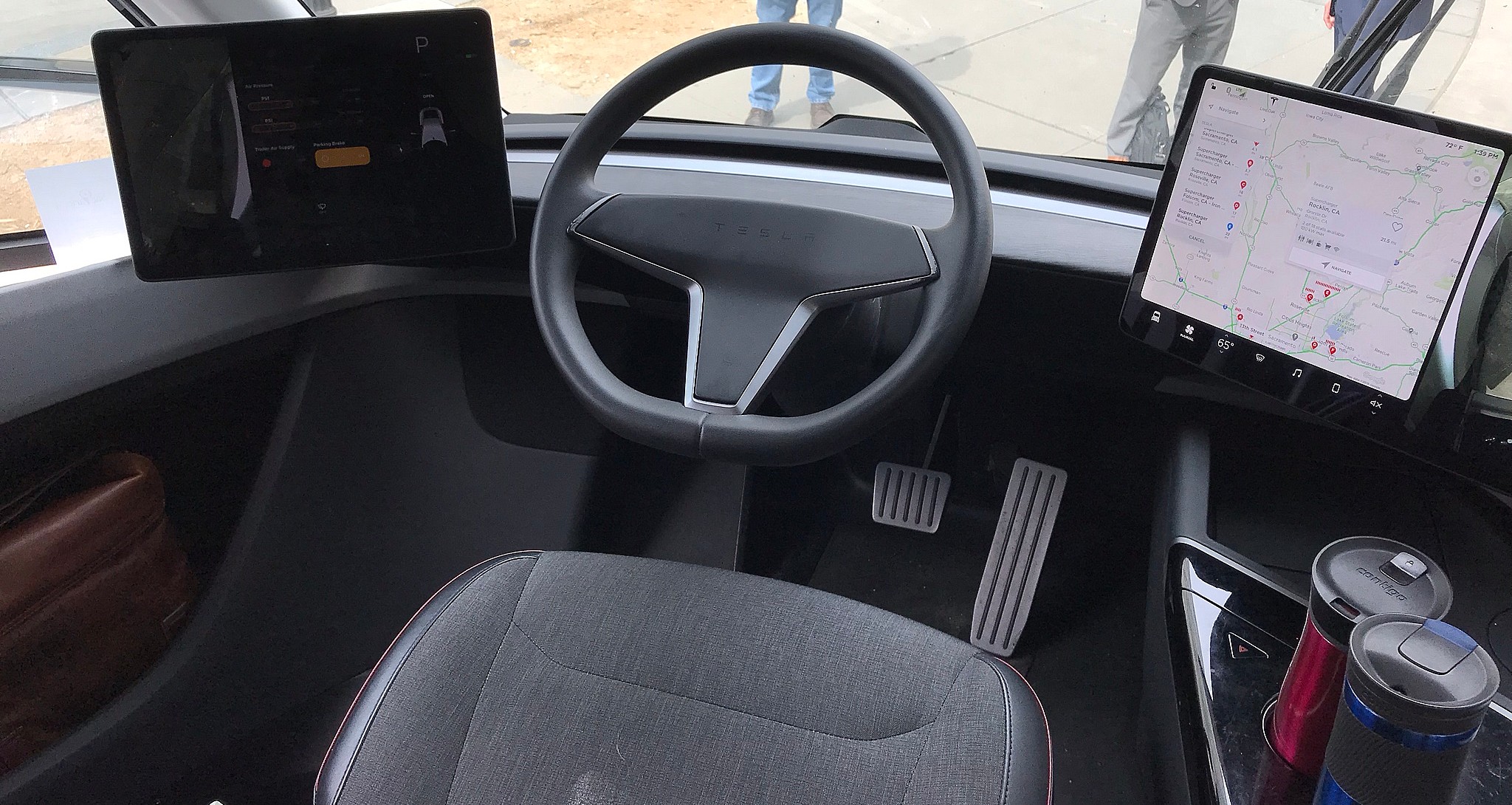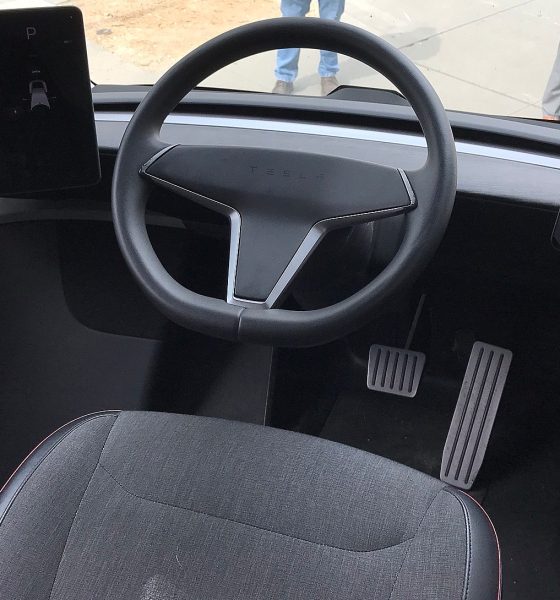

News
Tesla Semi cockpit details revealed in clearest interior pictures yet
The Tesla Semi was recently showcased in Sacramento, CA for the CALSTART Advanced Tech Vehicle Display and the 2030 Clean Transportation Summit Reception, and it was in the area long enough for some enthusiasts to capture detailed photographs of its interior. The images reveal a Model 3-esque interface, a mysterious third pedal, and a vehicle that is battle-scarred from thousands of miles of real-world testing.
Tesla community member u/rygel_fievel from the r/TeslaMotors subreddit noted that the Semi looks like a vehicle that is continually being used, as evidenced by the scratches on its piano black cup holders, stains on its driver’s seat, and even some bugs on the windshield. It remains to be seen why Tesla did not opt to detail the Semi before showcasing the vehicle in the event, but it is pretty difficult to deny that the all-electric truck definitely looks the part of a long-hauler that’s in constant service.

The Tesla Semi. (Photo: rygelfievel/Reddit) 
The Tesla Semi. (Photo: rygelfievel/Reddit)
Noticeable from one of the pictures of the truck’s interior is a small third pedal positioned beside the brake pedal. Tesla has not posted any details about this particular component, though speculations among the community suggest that the pedal is a mechanical parking brake, which is used in some vehicles. The twin Model 3-esque displays on both sides of the Semi’s steering wheel are also quite interesting, with the right display featuring Navigation, and the left being dedicated for the all-electric truck’s settings. The Semi’s left screen seems to feature a dark theme too, which makes its GUI really easy on the eyes.
The details on the Semi’s prototype’s interior are most definitely not finalized yet, but the current setup of the test vehicle is already well thought-out. The long-hauler’s central driving position gives a way for drivers to get a commanding view of the road, and the two side camera feeds on the left and right displays allow operators to see what’s happening in the Semi’s blind spots at all times. These design choices all but emphasize a central theme with the Semi: it will be a truck that is easy to operate, feature-rich, and most of all, safe.

The Tesla Semi. (Photo: rygelfievel/Reddit) 
The Tesla Semi. (Photo: rygelfievel/Reddit) 
The Tesla Semi. (Photo: rygelfievel/Reddit)
The Tesla Semi prototype being showcased at Sacramento is one of two working test mules for the vehicle. According to enthusiasts who previously sighted the Semi, the silver unit is a hand-built prototype that is largely made of carbon fiber. The vehicle is also reportedly equipped with a whopping 26-camera setup, some of which are installed on the truck’s side mirrors, rear, and windshield. The silver Semi prototype reportedly has a range of 300 miles per charge as well.
Being a Class 8 truck, the Tesla Semi has the potential to be a disruptor in the trucking market. The long-hauler shares components with the Model 3, such as its motors, door handles, air vents, and displays. Thanks to its four electric motors, the Semi can accelerate from 0-60 mph in 5 seconds flat without cargo. With a full load, the truck is still quick on its feet, hitting 60 mph in about 20 seconds. Tesla noted that the Semi would enter initial production sometime in 2019, though following statements by the electric car maker point to a ramp in 2020.

Elon Musk
Elon Musk’s X will start using a Tesla-like software update strategy
The initiative seems designed to accelerate updates to the social media platform, while maintaining maximum transparency.

Elon Musk’s social media platform X will adopt a Tesla-esque approach to software updates for its algorithm.
The initiative seems designed to accelerate updates to the social media platform, while maintaining maximum transparency.
X’s updates to its updates
As per Musk in a post on X, the social media company will be making a new algorithm to determine what organic and advertising posts are recommended to users. These updates would then be repeated every four weeks.
“We will make the new 𝕏 algorithm, including all code used to determine what organic and advertising posts are recommended to users, open source in 7 days. This will be repeated every 4 weeks, with comprehensive developer notes, to help you understand what changed,” Musk wrote in his post.
The initiative somewhat mirrors Tesla’s over-the-air update model, where vehicle software is regularly refined and pushed to users with detailed release notes. This should allow users to better understand the details of X’s every update and foster a healthy feedback loop for the social media platform.
xAI and X
X, formerly Twitter, has been acquired by Elon Musk’s artificial intelligence startup, xAI last year. Since then, xAI has seen a rapid rise in valuation. Following the company’s the company’s upsized $20 billion Series E funding round, estimates now suggest that xAI is worth tens about $230 to $235 billion. That’s several times larger than Tesla when Elon Musk received his controversial 2018 CEO Performance Award.
As per xAI, the Series E funding round attracted a diverse group of investors, including Valor Equity Partners, Stepstone Group, Fidelity Management & Research Company, Qatar Investment Authority, MGX, and Baron Capital Group, among others. Strategic partners NVIDIA and Cisco Investments also continued support for building the world’s largest GPU clusters.
News
Tesla FSD Supervised wins MotorTrend’s Best Driver Assistance Award
The decision marks a notable reversal for the publication from prior years, with judges citing major real-world improvements that pushed Tesla’s latest FSD software ahead of every competing ADAS system.

Tesla’s Full Self-Driving (Supervised) system has been named the best driver-assistance technology on the market, earning top honors at the 2026 MotorTrend Best Tech Awards.
The decision marks a notable reversal for the publication from prior years, with judges citing major real-world improvements that pushed Tesla’s latest FSD software ahead of every competing ADAS system. And it wasn’t even close.
MotorTrend reverses course
MotorTrend awarded Tesla FSD (Supervised) its 2026 Best Tech Driver Assistance title after extensive testing of the latest v14 software. The publication acknowledged that it had previously criticized earlier versions of FSD for erratic behavior and near-miss incidents, ultimately favoring rivals such as GM’s Super Cruise in earlier evaluations.
According to MotorTrend, the newest iteration of FSD resolved many of those shortcomings. Testers said v14 showed far smoother behavior in complex urban scenarios, including unprotected left turns, traffic circles, emergency vehicles, and dense city streets. While the system still requires constant driver supervision, judges concluded that no other advanced driver-assistance system currently matches its breadth of capability.
Unlike rival systems that rely on combinations of cameras, radar, lidar, and mapped highways, Tesla’s FSD operates using a camera-only approach and is capable of driving on city streets, rural roads, and freeways. MotorTrend stated that pure utility, the ability to handle nearly all road types, ultimately separated FSD from competitors like Ford BlueCruise, GM Super Cruise, and BMW’s Highway Assistant.
High cost and high capability
MotorTrend also addressed FSD’s pricing, which remains significantly higher than rival systems. Tesla currently charges $8,000 for a one-time purchase or $99 per month for a subscription, compared with far lower upfront and subscription costs from other automakers. The publication noted that the premium is justified given FSD’s unmatched scope and continuous software evolution.
Safety remained a central focus of the evaluation. While testers reported collision-free operation over thousands of miles, they noted ongoing concerns around FSD’s configurable driving modes, including options that allow aggressive driving and speeds beyond posted limits. MotorTrend emphasized that, like all Level 2 systems, FSD still depends on a fully attentive human driver at all times.
Despite those caveats, the publication concluded that Tesla’s rapid software progress fundamentally reshaped the competitive landscape. For drivers seeking the most capable hands-on driver-assistance system available today, MotorTrend concluded Tesla FSD (Supervised) now stands alone at the top.
News
Elon Musk’s Grokipedia surges to 5.6M articles, almost 79% of English Wikipedia
The explosive growth marks a major milestone for the AI-powered online encyclopedia, which was launched by Elon Musk’s xAI just months ago.

Elon Musk’s Grokipedia has grown to an impressive 5,615,201 articles as of today, closing in on 79% of the English Wikipedia’s current total of 7,119,376 articles.
The explosive growth marks a major milestone for the AI-powered online encyclopedia, which was launched by Elon Musk’s xAI just months ago. Needless to say, it would only be a matter of time before Grokipedia exceeds English Wikipedia in sheer volume.
Grokipedia’s rapid growth
xAI’s vision for Grokipedia emphasizes neutrality, while Grok’s reasoning capabilities allow for fast drafting and fact-checking. When Elon Musk announced the initiative in late September 2025, he noted that Grokipedia would be an improvement to Wikipedia because it would be designed to avoid bias.
At the time, Musk noted that Grokipedia “is a necessary step towards the xAI goal of understanding the Universe.”
Grokipedia was launched in late October, and while xAI was careful to list it only as Version 0.1 at the time, the online encyclopedia immediately earned praise. Wikipedia co-founder Larry Sanger highlighted the project’s innovative approach, noting how it leverages AI to fill knowledge gaps and enable rapid updates. Netizens also observed how Grokipedia tends to present articles in a more objective manner compared to Wikipedia, which is edited by humans.
Elon Musk’s ambitious plans
With 5,615,201 total articles, Grokipedia has now grown to almost 79% of English Wikipedia’s article base. This is incredibly quick, though Grokipedia remains text-only for now. xAI, for its part, has now updated the online encyclopedia’s iteration to v0.2.
Elon Musk has shared bold ideas for Grokipedia, including sending a record of the entire knowledge base to space as part of xAI’s mission to preserve and expand human understanding. At some point, Musk stated that Grokipedia will be renamed to Encyclopedia Galactica, and it will be sent to the cosmos.
“When Grokipedia is good enough (long way to go), we will change the name to Encyclopedia Galactica. It will be an open source distillation of all knowledge, including audio, images and video. Join xAI to help build the sci-fi version of the Library of Alexandria!” Musk wrote, adding in a later post that “Copies will be etched in stone and sent to the Moon, Mars and beyond. This time, it will not be lost.”








